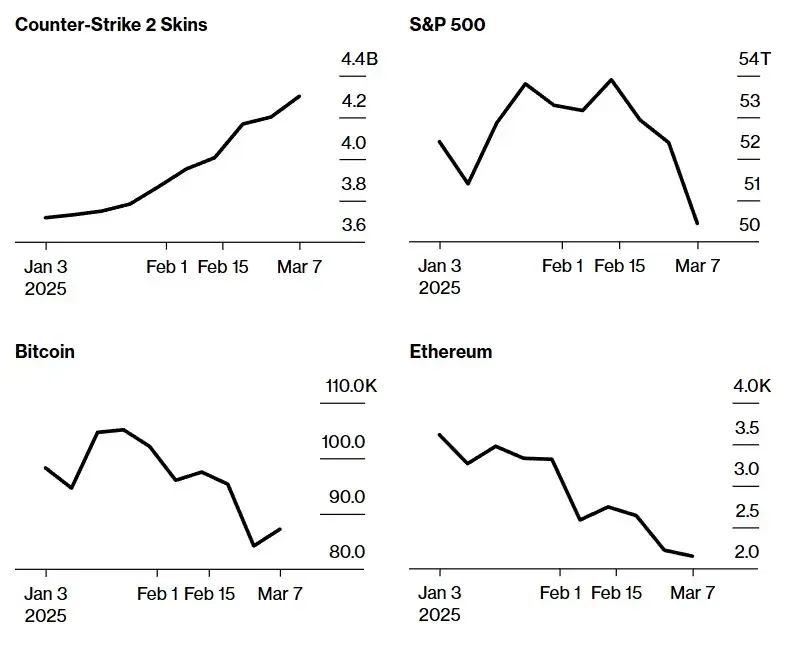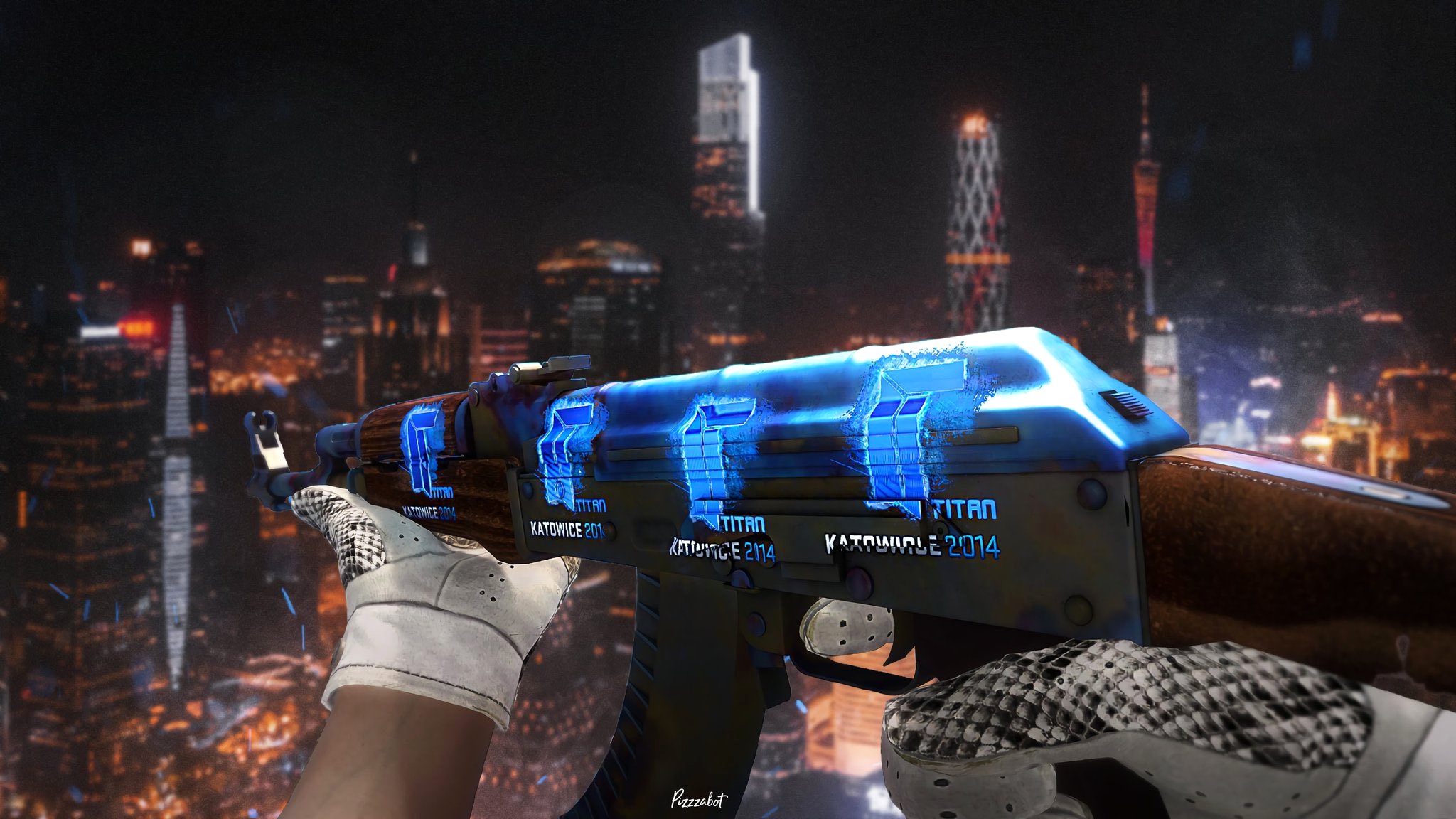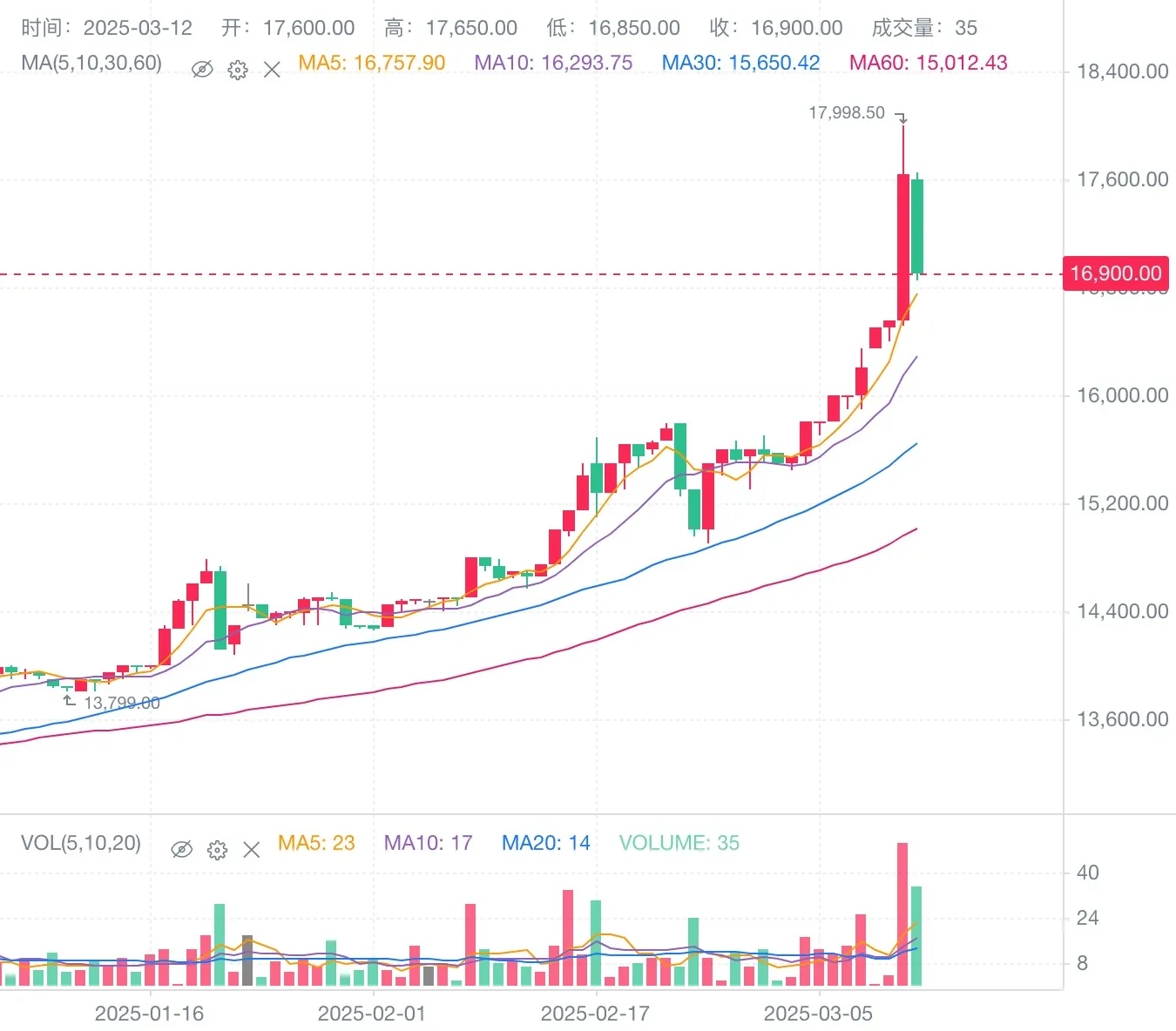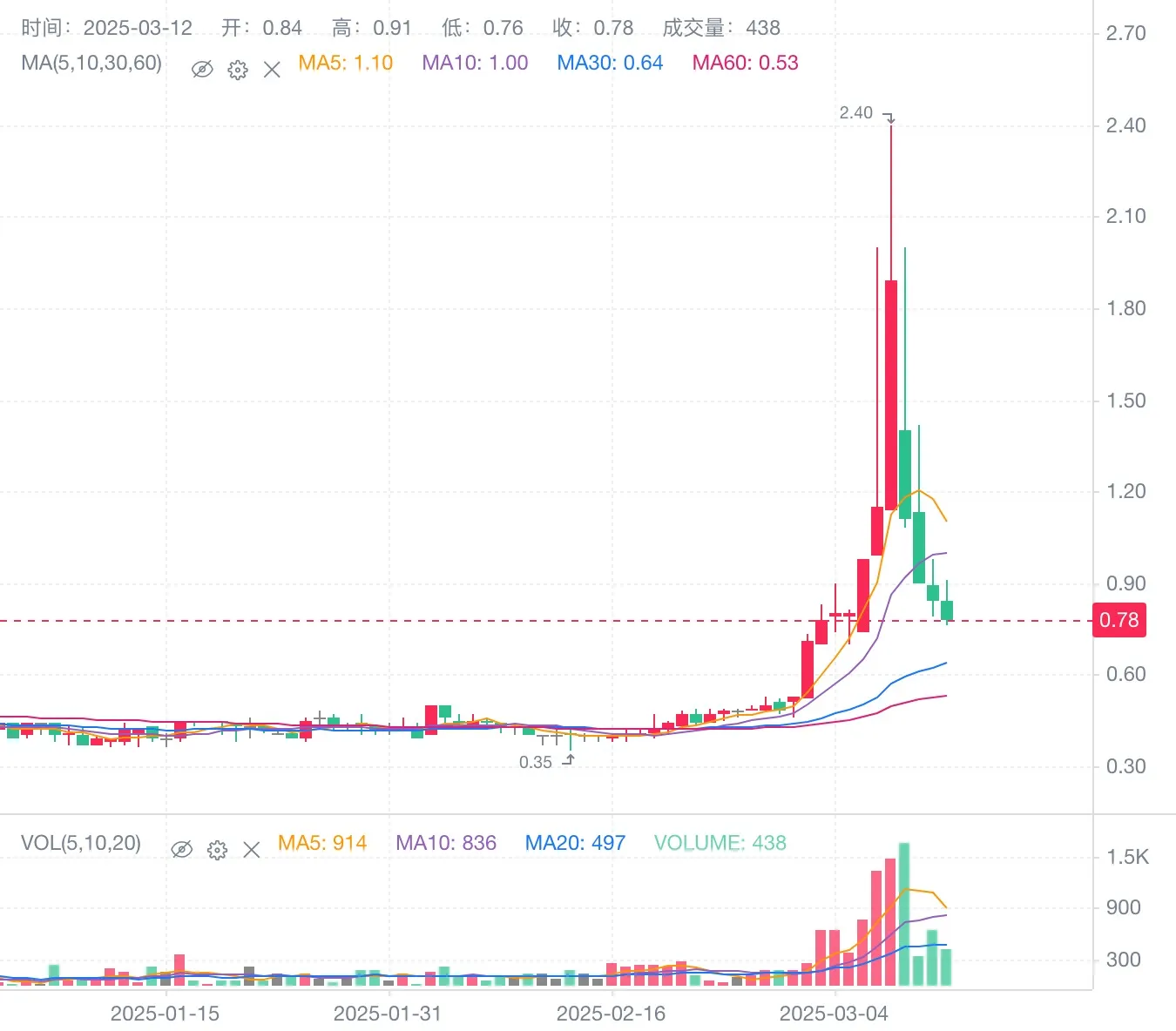
Original: msfew
Translation: Yuliya, PANews
Recently, the prices of CS2 items have surged significantly, while the US stock and cryptocurrency markets have seen declines. In contrast, gaming not only brings enjoyment but also creates profit opportunities, while cryptocurrency trading can be exhausting and prone to losses.
This article will explore the characteristics of the CS2 item market from the perspective of a seasoned CS2 player and analyze its potential integration with blockchain technology. As a mature digital asset market that has existed for many years, the CS2 item trading system may provide valuable insights for the blockchain industry.

CS2 Items
CS2 items share many similarities with NFTs. Each weapon model has different skin styles and is categorized based on wear (similar to the rarity of NFTs) and specific random patterns (for example, a fully blue "Factory New" AK-47 can be worth hundreds of thousands of dollars).

Items are mainly divided into the following categories:
- Weapon Skins: The most common, with prices varying based on weapon model and style.
- Knife Skins: Rare drops, with significant visual differences between default knives and skin knives, priced higher and considered "blue-chip" assets.
- Glove Skins: More rare and expensive than knife skins, classified as high-end collectibles with lower liquidity.
- Stickers: Highly speculative, with some limited edition stickers (like Titan Holo) priced up to $60,000.
The main uses of these items include:
- Aesthetic Decoration: Players can obtain items through randomly dropped cases (keys must be purchased separately to unlock), and most players quickly equip skins for commonly used weapons to avoid using the default appearance.
- Investment Value: Due to scarcity (like knife skins), prices rise with demand. The market has low liquidity and is easily manipulated (for example, "pump and dump" schemes with unpopular stickers). Compared to the cryptocurrency market, CS2 players generally have less investment experience, making them more susceptible to being targeted.
- Trading Medium: Used as prizes or collateral on gambling platforms.
Trading Model
CS2 item trading is similar to NFTs, utilizing an order book mechanism. Common trading strategies include hoarding, hype creation, price manipulation, and selling, with price charts resembling candlestick charts on TradingView. The market relies on a continuous influx of new players and funds, essentially functioning as a game-themed Ponzi scheme.

Market participants mainly include:
- Players: Purchase items for in-game use.
- Investors: Speculate based on market fluctuations.
- Trading Platforms: Provide trading services (the Steam official market restricts withdrawals, leading to insufficient liquidity).
- Streamers/Professional Players: Promote specific items as KOLs, for example, professional player donk purchases opponent stickers during matches to create market buzz.

The Possibility of CS2 Items + Blockchain
1) CS2 Item AMM (Automated Market Maker)
Interestingly, the original inspiration for AMM came from Minecraft HyperConomy in 2012. Currently, CS2 item trading uses an order book model, similar to the NFT market, with significant liquidity issues. Many items remain unsold for days, ultimately having to be sold below market price, creating a downward price spiral.
To improve the trading experience, an AMM (Automated Market Maker) mechanism could be introduced:
- Pure Off-Chain Model: Requires the development of aggregator protocols to consolidate buy and sell orders from multiple platforms, improving trading efficiency, or independent liquidity pools established by market makers (similar to Sudoswap). However, this method relies on centralized market makers, and the user experience remains limited.
- On-Chain Mapping Model: Could borrow from the tokenization of RWA, mapping items onto the chain and providing price data through oracles, then constructing liquidity pools. However, this method only optimizes the trading experience and does not truly promote the actual circulation of items.
2) Short Selling and Leverage Trading
If CS2 items could be shorted and support leverage trading, the market might experience more aggressive price fluctuations, while some low-value items could return to reasonable pricing.
The CS2 item market already has similar mechanisms, such as item rental models, where some players rent items for 100 days to short them. Additionally, Steam's 7-day trading cooldown period essentially equates to a 7-day expiration time for European options. Therefore, a derivative trading system could be designed based on traditional short-selling mechanisms.
The key challenge lies in the liquidation mechanism. Currently, if the market rises, some users borrowing items may directly "run away," causing the platform to incur losses. The perpetual contracts in cryptocurrency could serve as a reference, designing perpetual contracts for items based on market prices. For example, using the price of "AWP Dragon Lore" as a benchmark, allowing leveraged long and short trading, with the platform calculating funding rates at certain intervals to ensure market stability.
3) CS2 Item Index Fund
The CS2 item market naturally possesses the conditions for constructing an index fund. For example, indices could be categorized by item type.

The design of traditional index funds needs no elaboration; on the blockchain, DAO governance fund structures could be introduced, allowing users to stake high-value items in exchange for fund shares and enabling fractional trading of items. This mechanism could enhance market liquidity while providing new investment opportunities.
4) Infrastructure Development
Opportunities that are VC-friendly but have lower income:
- Data Analysis: Similar to gmgn.ai, integrating market trading data to provide real-time quotes, historical trends, market depth, etc., and supporting "one-click buy/sell" functions to simplify the trading process (avoiding frequent logins to Steam for trade confirmations).
- Market Intelligence: Tracking item holding data, analyzing the trading behavior of KOLs and professional players to assist investment decisions.
- Custody and Security: Establishing a professional CS2 item custody platform, employing multi-signature and cold storage (cold Steam accounts) to ensure user asset security.
Other directions include API services, insurance platforms, security tools, transaction front-running (MEV) mechanisms, social/community platforms, etc. However, the fundamental reason for the current low trading efficiency lies in Steam's restrictions. Even if on-chain solutions can optimize the experience to some extent, they cannot fundamentally change the liquidity issues within the Steam ecosystem.
Other Key Points (from DeepSeek)
- Centralization Risks: Although CS2 items are similar to NFTs, their ownership belongs to Steam, posing risks of platform bans or rule changes (Steam officially resists NFTs to maintain its closed-loop economic system).
- Regulatory Arbitrage: Some Chinese players use item trading to circumvent foreign exchange controls, theoretically feasible, but actual losses are too high; unless there is a clear need for capital laundering, this path lacks attractiveness.
- Liquidity Layering: High-end items (like Dragon Lore, Gem Knives) mainly trade in OTC markets, with pricing mechanisms similar to cryptocurrency OTC markets. The player base for these top-tier items is highly concentrated, akin to the holder ecosystem of blue-chip NFTs like CryptoPunks.
- Wear Economics: There is a "pseudo-mystical" premium phenomenon in the 0.15-0.18 wear range, leading to additional premiums due to scarcity.
Position Management is Crucial
The combination of CS2 items + blockchain may be the only area where players can proudly say, "I not only defeated my opponents in the game but also successfully shorted and profited in the market!" This delicate balance between gaming and investment is the unique charm of the CS2 item market.
However, whether in gaming or investment, managing one's "position" is crucial. After all, even if you own the coolest skins, you may still have to budget carefully for armor during an economic round (Eco Round). True victory is not just about profits on paper but also the sense of achievement and joy gained from the game.
May every player dominate the arena and confidently secure victory in the market. Now, it's time to put down the analysis and return to the battlefield.
免责声明:本文章仅代表作者个人观点,不代表本平台的立场和观点。本文章仅供信息分享,不构成对任何人的任何投资建议。用户与作者之间的任何争议,与本平台无关。如网页中刊载的文章或图片涉及侵权,请提供相关的权利证明和身份证明发送邮件到support@aicoin.com,本平台相关工作人员将会进行核查。




